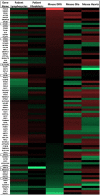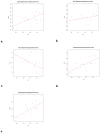Potential biomarker identification for Friedreich's ataxia using overlapping gene expression patterns in patient cells and mouse dorsal root ganglion
- PMID: 31665133
- PMCID: PMC6821053
- DOI: 10.1371/journal.pone.0223209
Potential biomarker identification for Friedreich's ataxia using overlapping gene expression patterns in patient cells and mouse dorsal root ganglion
Abstract
Friedreich's ataxia (FA) is a neurodegenerative disease with no approved therapy that is the result of frataxin deficiency. The identification of human FA blood biomarkers related to disease severity and neuro-pathomechanism could support clinical trials of drug efficacy. To try to identify human biomarkers of neuro-pathomechanistic relevance, we compared the overlapping gene expression changes of primary blood and skin cells of FA patients with changes in the Dorsal Root Ganglion (DRG) of the KIKO FA mouse model. As DRG is the primary site of neurodegeneration in FA, our goal was to identify which changes in blood and skin of FA patients provide a 'window' into the FA neuropathomechanism inside the nervous system. In addition, gene expression in frataxin-deficient neuroglial cells and FA mouse hearts were compared for a total of 5 data sets. The overlap of these changes strongly supports mitochondrial changes, apoptosis and alterations of selenium metabolism. Consistent biomarkers were observed, including three genes of mitochondrial stress (MTIF2, ENO2), apoptosis (DDIT3/CHOP), oxidative stress (PREX1), and selenometabolism (SEPW1). These results prompted our investigation of the GPX1 activity as a marker of selenium and oxidative stress, in which we observed a significant change in FA patients. We believe these lead biomarkers that could be assayed in FA patient blood as indicators of disease severity and progression, and also support the involvement of mitochondria, apoptosis and selenium in the neurodegenerative process.
Conflict of interest statement
The authors have declared that no competing interests exist.
Figures





References
Publication types
MeSH terms
Substances
Grants and funding
LinkOut - more resources
Full Text Sources
Medical
Molecular Biology Databases
Research Materials
Miscellaneous

